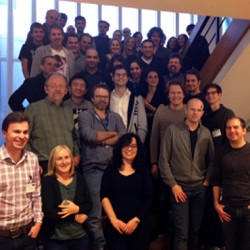By Helen Figueira
December 2, 2013
Time to read: 3 minutes
 Highlights from the CSC/MDC retreat
Highlights from the CSC/MDC retreat
Early in November, the CSC hosted its second international retreat with the Berlin Institute of Medical Systems Biology (BIMSB, a new branch of the Max Delbruck Centre) and colleagues from Barcelona’s Centre for Genomic Regulation (CRG).
The meeting kicked off with a discussion of how circular RNAs act as sponges to mop up microRNAs [1] (Nikolaus Rajewsky) and new evidence of promoter shifting as zebrafish embryos develop [2] (Boris Lenhard). These discoveries were a nice taster for the series of short presentations (and longer discussions) that followed, peppering the day with illustrations of how systems-based approaches could be applied to important questions in biology. The first day ended with a trip to the Tate Modern, where CSC guests sampled the traditional English fare of fish, chips and mushy peas and wandered through a selection of contemporary art installations. Science-talk continued as guests and hosts self-organised into groups to enjoy London’s nightlife, agreeing to re-convene at the Hammersmith Campus the following morning.
The start of the second session saw Ben Lehner convincing a somewhat bleary-eyed audience that systems biology could render ‘even sloppy experiments valuable’. While this was clearly music to the ears of several newly appointed PhD students, his study elegantly showed how local and distant genetic variation affects gene expression dynamics during worm development [3], and provided a template for human studies of physiology and disease progression. After a series of similarly inspirational short talks throughout day two, the session closed with participants clearly wanting more. To capture this enthusiasm and to foster newly formed collaborations the participants agreed to have a ‘rematch’ before too long, and considered hosting a joint scheme for training PhD students and postdocs. What’s more, despite the usual reticence of scientists for paparazzi coverage, the group volunteered to have its photograph taken.
References
[1] Circular RNAs are a large class of animal RNAs with regulatory potency.
Memczak S, Jens M, Elefsinioti A, Torti F, Krueger J, Rybak A, Maier L, Mackowiak SD, Gregersen LH, Munschauer M, Loewer A, Ziebold U, Landthaler M, Kocks C, le Noble F, Rajewsky N.
Nature. 2013. doi: 10.1038/nature11928.
[2] Two independent transcription initiation codes overlap on vertebrate core promoters.
Haberle V, Li N, Hadzhiev Y, Plessy C, Previti C, Nepal C, Gehrig J, Akalin A, van IJcken W, Armant O, Ferg M, Strähle U, Carninci P, Müller F, Lenhard B. Nature. 2014.doi: 10.1038/nature12974.
[3] The effects of genetic variation on gene expression dynamics during development.
Francesconi M, Lehner B. Nature. 2013. doi: 10.1038/nature12772